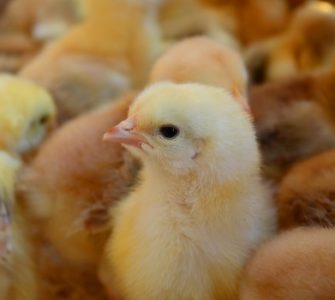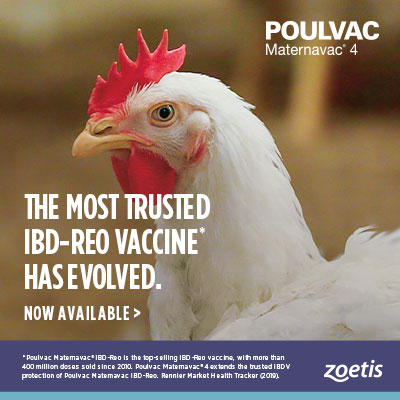New Poulvac Maternavac® 4 vaccine formulated to address contemporary field challenge
The rapid growth in reduced and “no antibiotics ever” production was the driving force behind development of a new vaccine to protect chickens against four costly diseases.
“Viruses alone can take a heavy toll on flocks, but they also predispose birds to bacterial infections that were once contained with the use of antibiotics,” explained Kalen Cookson, DVM, MAM, director of clinical research, Zoetis.
“Several of our customers eliminating antibiotics from their systems were struggling to maintain broiler health and clearly needed a way to improve immunity. And there is always concern about labor costs and stress on hens when multiple injections have to be given.”
Because immunity in broilers needs to start with broiler breeders, Zoetis scientists were charged with developing an inactivated vaccine that would provide a high level of protection for primed hens and for their offspring against infectious bursal disease virus (IBDV), reovirus and Newcastle disease virus (NDV). The vaccine — later designated Poulvac Maternavac® 4 — would also help protect hens against infectious bronchitis virus (IBV) during lay without requiring an additional vaccine injection.
Several years of research had already led to the development of Poulvac Maternavac® IBD-Reo, a vaccine with a reputation in the industry for efficacy against IBDV and reovirus. The challenge was making sure that adding antigens from two other viruses wouldn’t compromise IBDV protection, especially against circulating IBDV variants.
“We wanted a vaccine that would build on the success of Poulvac Maternavac IBD-Reo and establish a solid base of immunity for each of the diseases it targeted,” Cookson said.
He added that protection against IBDV is a foremost concern for poultry producers because the virus not only destroys the bursa, its impact on the overall immune system can be devastating.1 Recent research indicates IBDVs also have an adverse effect on the development of gut-associated lymphoid tissues and on the composition of the microflora, raising the possibility that bad bacteria can invade via the gut.2
According to Cookson, the AL2 family of IBDVs has predominated in the US for the last 2 decades and still reigns. Data gathered by Zoetis from US poultry companies from 2015 to 2019, for instance, showed that over half of the IBDV field variants are AL2-type viruses.3
“In fact, one major poultry producer we work with found that over 60% of its IBDV isolates were in the AL2 family,” he said.
‘100% protection’ in a challenge study
To ensure the new vaccine protected against IBDV as well as its predecessor, Zoetis conducted a controlled challenge study with 300 hens. Investigators vaccinated birds with either Poulvac Maternavac 4 or Poulvac Maternavac IBD-Reo. They left some birds unvaccinated to serve as a control group. All hens in the study were challenged with the AL2 and Delaware-E strains of IBDV.
Both vaccines provided 100% protection against the AL2 challenge and from 95% to 100% protection against the Delaware-E strain of IBDV, Cookson reported (Table 1).4
The studies, he noted, employed fractional doses, which is standard practice in the industry for vaccine development because it helps gauge the type of protection that hens may confer to offspring. Fractional dose studies are used strictly in research, however. Hens must receive the full dose for their protection and to pass along optimal immunity to broilers.
“The antigen that really drives the IBDV part of Poulvac Maternavac 4 is the patented Group-6 variant virus, which was selected for its cross-protective properties,” Cookson continued. It’s of bursal-tissue origin and, of all the four-way vaccines on the market, it’s the only one with a Group-6 variant, which has become more prominent in recent years. The other IBDV antigen in the vaccine is the Lukert strain — noted for its ability to cross-protect better against variant IBDVs than other classic strains,5 he said.
Comparative study
Poulvac Maternavac 4 was also tested against three competitive vaccines in another controlled study involving more than 570 hens.6 Investigators vaccinated birds with fractional doses of one of the four vaccines and then challenged them with the AL2 strain and with the two most common AL2 sub-types, AL2-b and AL2-c.
“Poulvac Maternavac 4 clearly gave the most consistent immune response based on protection against the panel of AL2 challenges,” Cookson said (Table 2).

Treatments within a column that share a letter are not significantly different (P ≤ 0.05). B:BW is the bursa to bodyweight ratio.
“Because our two-way vaccine, Poulvac Maternavac IBD-Reo, was originally designed to improve AL2 protection, we weren’t surprised that the new four-way vaccine demonstrated the most consistently high levels of protection against AL2 and the two most common sub-types,”7 he noted.
Previous studies have demonstrated the IBDV antigens in Poulvac Maternavac 4 also protect against the IBDV variant 9109, known as the “Hillbilly virus.”8
IBDV-reovirus balance
The reovirus antigens in Poulvac Maternavac 4 are the classic tenosynovitis 1733 and malabsorption 2408 strains, Cookson said. It’s been demonstrated that broilers from hen flocks with higher classic reovirus titers have significantly higher bodyweights (P = 0.0501) and less footpad swelling after intra-tracheal challenge with variant Group-1 reovirus (Genotype 5).9
“Balancing the IBDV and reovirus antigens in the new vaccine was key,” Cookson said. “We’ve found that with bursal-derived IBDV production, the IBDV antigen mass goes way up, but the reovirus titer response can go down if the reovirus formulation is not adjusted. We’ve addressed that imbalance between these viral antigens, and the result is an excellent IBDV titer response and much better reovirus titers. This sets our vaccine apart from others,” he said.
In addition, Poulvac Maternavac 4 is a conventional, water-in-oil emulsion which Cookson said in his experience yields a more persistent titer response compared to vaccines that are more water soluble. “Persistence is especially relevant regarding the reovirus fraction,” he said.
Unique Newcastle antigen
The NDV antigen in Poulvac Maternavac 4 is a highly immunogenic mesogenic strain. “The mesogenic NDV strain is another feature of the vaccine that sets it apart from others of its kind,” Cookson said.
NDV is a threat for all poultry operations, and the virulent form of the disease has become a serious concern in some areas of the country, he said. “If broilers in a high-challenge area receive a live B-1 Newcastle vaccine, we expect that maternal antibodies they’ve acquired from the Newcastle disease antigen in Poulvac Maternavac 4 will take the edge off a vaccine reaction.”
IBV breeder priming
The Massachusetts IBV strain in Poulvac Maternavac 4, Cookson said, significantly enhances the titer response to the live priming program and provides a solid foundation of protection for hens during lay, which was demonstrated in a layer field study.10 It can help prevent silent-layer syndrome in progeny, which occurs when pullets are exposed early in life to IBV. Hens can appear normal but have reproductive damage.
It should not be assumed that an inactivated vaccine containing the Arkansas IBV strain will provide better protection against Arkansas IBV, said Cookson, who added, “The key to setting up bronchitis immunity is live priming of pullets with a diversity of serotypes, followed by the killed vaccine.”
He concluded that Poulvac Maternavac 4 should help broiler breeders and their progeny establish immunity against IBDV, reovirus and NDV and, at the same time, help protect hens against IBV during lay. Stepping up to the four-way vaccine conveniently lets producers bolster NDV and IBV immunity without the added labor cost and stress of an additional injection.
“Vaccination of broiler breeders against important and costly diseases with a vaccine that protects hens and passes on protection to broilers for key diseases translates into better performance and a better bottom line for producers,” Cookson said.
All trademarks are the property of Zoetis Services LLC or a related company or a licensor unless otherwise noted.
1 Rehman ZU, et al. Interaction of infectious disease virus with the immune system of poultry. World’s Poult Sci J. 2016 Dec.;72(4):805-820.
2 Li L, et al. Infectious bursal disease virus infection leads to changes in the gut associated-lymphoid tissue and the microbiota composition. PLoS One. 2018;13(2):e0192066.
3 Cookson K, Featherson S, Barker A, Schaeffer J. A survey of wild type IBDV isolated from broiler flocks in the United States since 2014. Proc. Southern Conference of Avian Diseases, Atlanta, GA. 2020.
4 Data on file. Study No. 032419-KL-70AQOKC-6020, Zoetis LLC.
5 Ismail NM, Saif YM. Immunogenicity of infectious bursal disease viruses in chickens. Avian Dis. 1991;35:460-469.
6 Data on file. Study No. 040322-KC-70AQOKC-6121, Zoetis LLC.
7 Ismail NM, Saif YM. Immunogenicity of infectious bursal disease viruses.
8 Data on file. Study No. 02-16-7RCSL, Zoetis LLC.
9 Cookson K, et al. Comparison of reovirus challenge viruses s-1133 and variant Group-1 in two commercial broiler flocks with different maternal immunity levels. Abstracts, International Poultry Scientific Forum, Atlanta, 2014.
10 Cookson K, et al. A comparison of 46-week serology and IBV Arkansas protection in flocks receiving different commercial SE bacterins. 66th Western Poultry Disease Conference. 2017.
DISCOVERIES, Issue 6
Discoveries is a series of research news reports written by the editors of Poultry Health Today on behalf of the US Poultry Business of Zoetis.
BIO-00227
May 2020
Posted on July 23, 2020
















